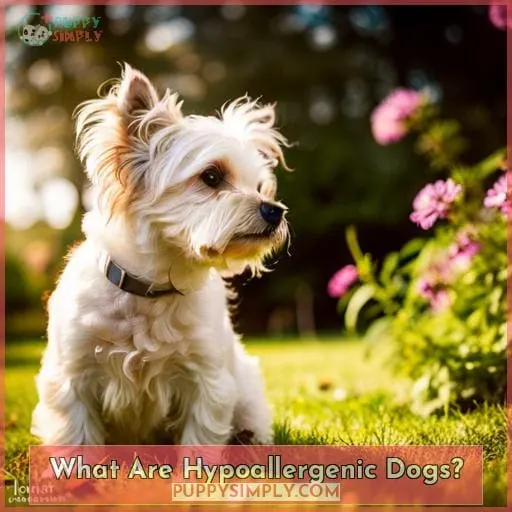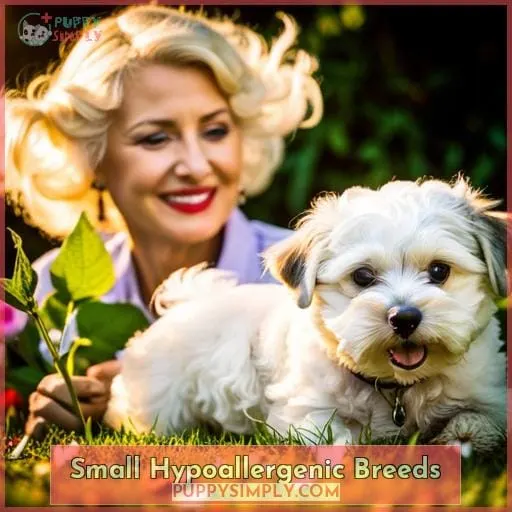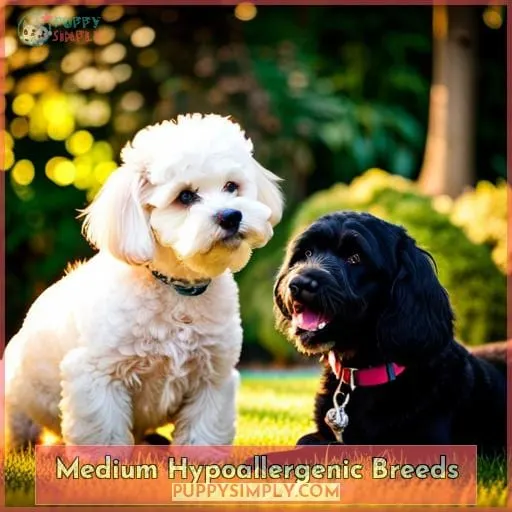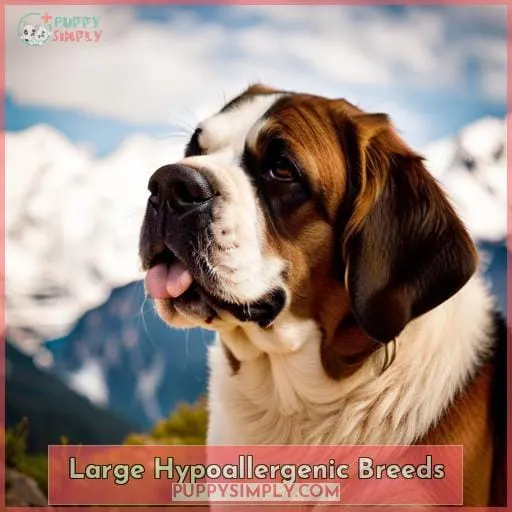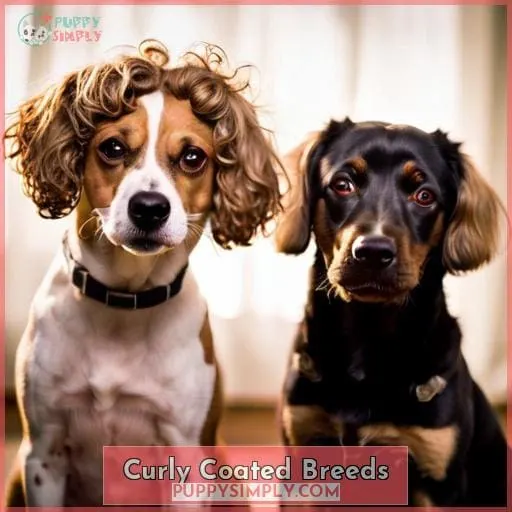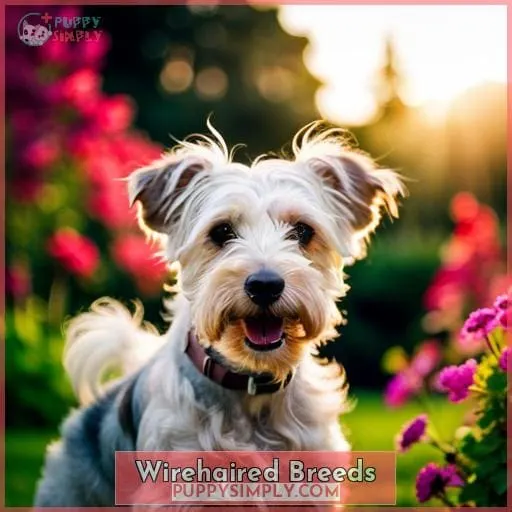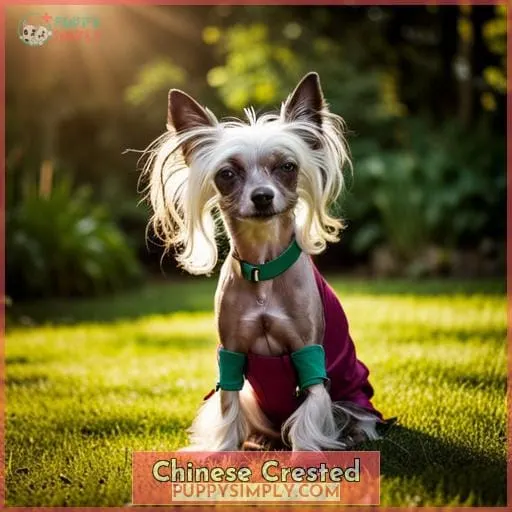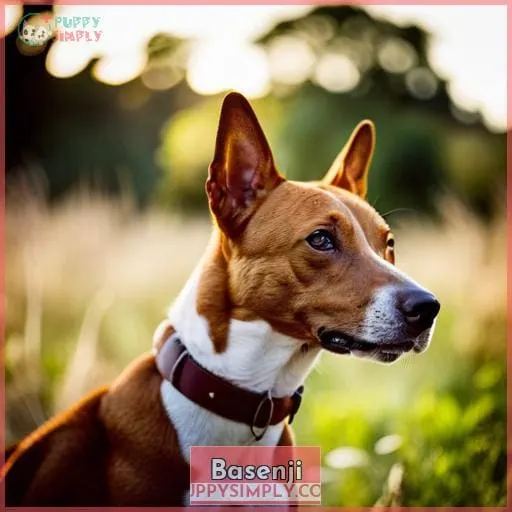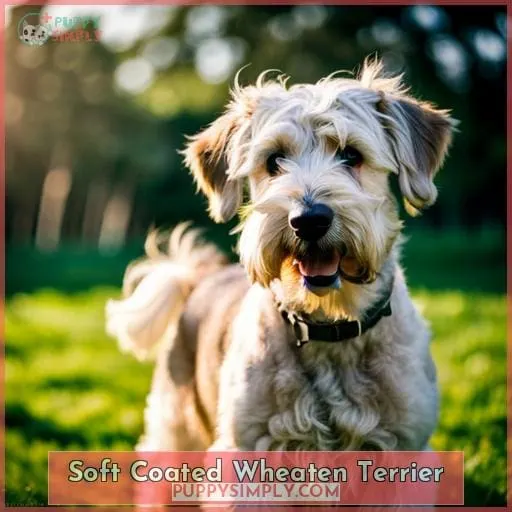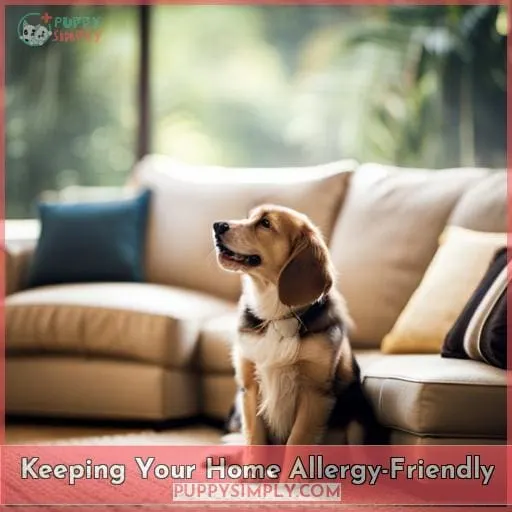This site is supported by our readers. We may earn a commission, at no cost to you, if you purchase through links.
 You’ve struggled with dog allergies but long for a furry companion. Fortunately, some breeds shed less dander.
You’ve struggled with dog allergies but long for a furry companion. Fortunately, some breeds shed less dander.
As a canine expert, I’ll highlight non-shedders that could enable a less allergenic home.
While no dog is completely hypoallergenic, particular breeds and proper care reduce symptoms.
I’ll share top low-shedding small, medium, and large picks, plus tips ensuring your health and happiness with an understanding fur pal.
Table Of Contents
Key Takeaways
- Focus on non-shedding breeds like Poodles or Schnauzers for potentially hypoallergenic dogs.
- Consider mixed breeds like Labradoodles that can inherit non-shedding coats from Poodle lineage.
- Small hypoallergenic options include Havanese, Maltese, and Shih Tzus.
- Large hypoallergenic breeds can include Afghan Hounds and Poodles.
What Are Hypoallergenic Dogs?
You’re probably wondering what exactly hypoallergenic dogs are.
Simply put, they’re breeds less likely to trigger allergic reactions.
Many people wrongly assume hypoallergenic means non-allergenic.
No dog is 100% allergy-proof, but some shed less dander and saliva.
Focus on non-shedding breeds like poodles or Schnauzers.
Also consider mixed breeds like labradoodles, which can inherit non-shedding coats.
Regardless of breed, bathe your dog frequently and vacuum diligently.
Air purifiers also help.
While no guarantees exist, thoughtful choices maximize allergy-friendly living.
Talk to your vet about breeds fitting your lifestyle and sensitivity.
Review pet insurance to offset costs too.
With research and precautions, dog lovers can often manage allergies.
The key is choosing the right hypoallergenic breed for you.
Small Hypoallergenic Breeds
You’ll also want to consider some of the more petite hypoallergenic breeds.
The Havanese, Maltese, and Shih Tzu are all under 13 inches tall yet have the non-shedding coats ideal for allergy sufferers.
Their small size also means they produce less dander and saliva than larger dogs.
Havanese
You’ll love the Havanese for its silky, non-shedding coat that produces less dander to trigger allergies.
Requires regular grooming.
Friendly and affectionate.
Moderate exercise needs.
Eager to please in training.
Relatively healthy.
The Havanese is a great small hypoallergenic breed with a silky coat that hardly sheds. This playful and gentle companion thrives on attention and activity. With consistent grooming and training, the Havanese makes an ideal pet for allergy sufferers seeking a loving furry friend.
Maltese
When you’re searching for a tiny hypoallergenic dog breed, consider the Maltese.
Gentle, playful, and affectionate, the Maltese sheds minimally with its long, silky, non-shedding coat.
This toy breed requires regular brushing and combing to prevent mats and tangles.
The Maltese is eager to please, making training enjoyable.
Its sweet temperament thrives on human companionship.
Some health issues to watch for include:
- Patellar luxation
- Hypoglycemia
- White shaker dog syndrome
Daily play sessions meet the Maltese’s modest exercise needs.
Grooming:
- Regular brushing/combing
- Prevent mats and tangles
Training:
- Eager to please
- Enjoyable
Health:
- Patellar luxation
- Hypoglycemia
- White shaker dog syndrome
Shih Tzu
One should know the Shih Tzu breed has a long, silky, non-shedding coat that makes them a good choice for allergy sufferers looking for a small hypoallergenic dog.
Require regular grooming.
Friendly and outgoing temperament.
Need daily exercise.
Prone to certain health issues.
The Shih Tzu is a great companion for those seeking a friendly, lively, and affectionate small hypoallergenic breed. Their beautiful coats require diligent grooming to stay healthy and non-shedding.
Medium Hypoallergenic Breeds
You’ll also want to consider some medium-sized hypoallergenic options.
Like the energetic Portuguese Water Dog or the alert and active Standard Schnauzer.
Both breeds shed minimally and tend to be friendly, loyal companions that thrive when given plenty of exercise and mental stimulation.
Their medium size makes them a bit easier to handle than a larger breed while still substantial enough for an active family.
Portuguese Water Dog
After learning about small hypoallergenic breeds like the Havanese, Maltese, and Shih Tzu, you’re ready to explore medium-sized options.
Starting with the intelligent and friendly Portuguese Water Dog.
This curly-coated breed is hypoallergenic thanks to its single-layer coat that doesn’t shed much.
Be prepared to brush them thoroughly and clip their coat every few months.
Their high energy also demands plenty of swimming, running, and interactive play.
Use positive reinforcement when training these eager workers who excel at obedience, agility, and even water rescue.
Standard Schnauzer
The standard schnauzer is another medium-sized hypoallergenic breed with a wiry coat that produces little dander to trigger allergies.
This energetic and loyal companion has a weather-resistant coat perfect for those seeking a dog for the outdoors.
With modest grooming needs, a standard schnauzer makes a wonderful hiking or jogging partner.
However, without enough exercise and stimulation, they may develop some undesirable behaviors.
Consistent training and daily activity help this intelligent breed thrive in an active home.
Their medium size, minimal shedding coat, and energetic yet trainable temperament make the standard schnauzer a great choice.
Large Hypoallergenic Breeds
You’ll want to consider larger hypoallergenic breeds like the Standard Poodle and Afghan Hound if you have the space and lifestyle to meet their needs.
These intelligent, independent dogs require regular grooming and moderate exercise.
But their minimal shedding makes them better choices for allergy sufferers looking for a big companion.
Just be prepared to put in the time training and exercising an active working breed like the Standard Poodle or sighthound Afghan.
Afghan Hound
You’re in for a treat with the Afghan Hound’s long, silky coat yet minimal shedding if you’re seeking a large-sized hypoallergenic dog.
Though frequent grooming keeps shedding and dander at bay, their catlike demeanor and occasional aloofness require understanding.
Daily walks and weekly sprints in enclosed areas satisfy their moderate exercise needs.
Their sweet yet independent temperament shines through silly antics when comfortable.
Though no breed is 100% hypoallergenic, their minimal dander makes Afghan Hounds ideal for many allergy sufferers seeking loyal, loving companions.
Washing bedding weekly further aids allergy management.
Poodle
Having looked at the Afghan Hound, you’re now considering the Poodle as another large hypoallergenic breed option.
The Poodle’s curly, non-shedding coat requires regular grooming to prevent matting.
Their intelligence makes training a joy, though their active nature demands good exercise.
While no breed is 100% hypoallergenic, Poodles produce less dander and saliva than most, making them a top choice for allergy sufferers.
Consider their needs for:
- Daily brushing and professional grooming
- Mental stimulation through training
- Regular walks and playtime
When provided proper care and attention, Poodles thrive in allergy-friendly homes.
Their smart and silly temperaments endear them to many.
Curly Coated Breeds
Among the top hypoallergenic dogs are those with curly coats that don’t shed much dander to trigger allergies.
The petite, fluffy Bichon Frise and the larger Irish Water Spaniel both have thick curly coats perfect for allergy sufferers looking for a cute canine companion.
With professional grooming, these curly-locked pups can be ideal additions to households prone to dog allergies.
Bichon Frise
You can consider the curly-coated Bichon Frise.
It sheds minimally and tends to be gentle and playful, though it requires regular grooming.
As a veterinarian specializing in hypoallergenic breeds, I advise researching grooming tips for this breed’s curly coat.
Their happy, friendly temperament makes Bichon Frises a joyful companion.
However, potential owners should consider their playful nature and need for daily activity.
Regular brushing and trims every 6-8 weeks promote coat and skin health.
An attentive family in an active home suits this loving breed’s needs.
Irish Water Spaniel
Your curly-coated Irish Water Spaniel sheds minimally, making it a hypoallergenic breed suitable for allergy sufferers.
This energetic sporting dog requires:
- Daily exercise
- Weekly brushing
- Positive reinforcement training
An affectionate family companion, the Irish Water Spaniel bonds closely with its owners.
Independent thinking and a touch of stubbornness can make training challenging. Setting clear expectations and staying patient is key to success with this breed.
Their tight curls keep dander contained, allowing people with allergies to enjoy their companionship.
Wirehaired Breeds
The Miniature Schnauzer and Scottish Terrier are two great wirehaired options for allergy sufferers.
Their wiry topcoats and soft undercoats shed minimally and produce little dander.
Check out these lively, loyal pups if you want a hypoallergenic dog with a distinctive scruffy look.
Miniature Schnauzer
Among wirehaired breeds, you’re looking at the Miniature Schnauzer as an excellent hypoallergenic choice.
With its wiry topcoat and soft undercoat that don’t shed much, their less shedding coats mean less dander.
However, they still require weekly brushing and grooming.
A Miniature Schnauzer needs 30-60 minutes of daily exercise.
As an intelligent and playful breed, they benefit from training and socialization starting as a puppy.
Monitor their health as Schnauzers are prone to diabetes and pancreatitis.
Overall, the Miniature Schnauzer makes a lively, fun-loving hypoallergenic companion when properly cared for.
Scottish Terrier
While the Miniature Schnauzer has a medium, wiry coat, your Scottish Terrier sports a longer, softer double coat that makes it another hypoallergenic choice among wirehaired breeds.
Scottish Terrier Grooming Tips:
- Brush weekly
- Hand strip coat twice yearly
-
Bathe as needed
Temperament Traits:
- Spirited
- Steadfast
-
Self-assured
Size and Weight:
- 10 inches tall
-
18-22 pounds
Allergy Considerations:
- Moderate shedding
- Wirehaired coat traps dander
Chinese Crested
The Chinese Crested is another hairless breed that produces minimal dander and is considered hypoallergenic.
It comes in two varieties: hairless and powderpuff.
The hairless variety has soft, silky hair on its head, tail, and feet.
This lively, affectionate breed makes a gentle companion.
The Chinese Crested is playful and generally good with children.
Regular bathing and moisturizing of the skin are needed.
Daily exercise satisfies this breed’s moderate activity needs.
Health issues to watch for include skin problems, patellar luxation, and progressive retinal atrophy.
Overall, the cute, hypoallergenic Chinese Crested can make a delightful pet for allergy sufferers seeking a hairless dog.
Basenji
You will keep away allergens with a Basenji.
The Basenji has a short, fine coat that produces little dander or shedding to bother allergy sufferers.
Alert and energetic
Reserved with strangers
Independent and stubborn
Intelligent and trainable
The Basenji temperament is intelligent yet independent. This hypoallergenic breed has easy-care grooming needs, requiring only weekly brushing.
Basenjis need lots of exercise and mental stimulation through interactive play and training.
Due to their independent nature, early socialization and consistency are key when training a Basenji.
Their short coat provides less dander and allergens compared to heavy shedding breeds.
Soft Coated Wheaten Terrier
With their silky, wavy coat keeping shedding to a minimum, the Soft Coated Wheaten Terrier’s even temperament and playfulness make them a great hypoallergenic option for you.
Grooming Needs:
- Require weekly brushing and combing to prevent matting
- Benefit from monthly baths
- Need regular nail trims
Temperament Traits:
- Happy, friendly, energetic
- Playful, intelligent, loyal
- Gentle, outgoing
Exercise Requirements:
- Need 30-60 minutes of exercise daily
- Enjoy activities like walking, playing fetch
- Prone to obesity without enough exercise
The Soft Coated Wheaten is a generally healthy breed with few major health problems. Providing them daily mental and physical stimulation will prevent behavior issues. Use positive reinforcement techniques when training this eager-to-please breed. Their medium-shedding coat makes them a solid hypoallergenic choice.
Keeping Your Home Allergy-Friendly
After selecting a hypoallergenic breed, you’ll also want to keep your home allergy-friendly.
Use allergy-friendly decor like hardwood or tile floors and washable fabrics.
Clean often to reduce dander and vacuum using a HEPA filter.
Consider air purifiers for rooms where your pet spends time.
Maintain pet-free zones like bedrooms.
Bathe and brush your dog frequently using hypoallergenic shampoos and tools to minimize dander.
With thoughtful choices in pet selection, home decor, cleaning routines, and grooming, you can make your home a haven for both you and your hypoallergenic dog.
Frequently Asked Questions (FAQs)
Are there any 100% hypoallergenic dogs?
No, unfortunately, there are no dog breeds that are 100% hypoallergenic.
While some dogs shed less and produce less dander, all dogs produce allergens to some degree.
Your best bet is to spend time with different breeds to see which cause the least reaction.
But be aware, even within the same breed, individual dogs vary in how allergenic they are.
How can I find a responsible breeder for a hypoallergenic puppy?
First, thoroughly vet breeders through breed clubs and rescue groups.
Ask to meet puppy parents and inspect facilities.
Responsible breeders value puppies over profit.
Make sure medical records are available.
A few warning flags:
- No questions asked
- Ready to ship
- No refunds
Caveat emptor!
What kinds of grooming do hypoallergenic dogs require?
You’ll need to regularly brush and comb their soft coats to prevent matting and tangling.
Bathing every month or two and trimming around the eyes and mouth keeps them looking tidy.
Daily tooth brushing and nail trims promote health.
Professional grooming may be needed periodically.
How much exercise do hypoallergenic dogs need each day?
Most hypoallergenic dogs need 30-60 minutes of exercise per day to stay happy and healthy.
Taking your pooch on daily walks, playing fetch, and engaging in canine sports like agility will keep their bodies and minds stimulated.
Just be sure to avoid overexertion in hot weather.
What health issues are common in hypoallergenic breeds?
Hip dysplasia in larger breeds like Standard Poodles.
Collapsed trachea in small breeds like Yorkshire Terriers.
Dental problems in breeds like Shih Tzus with flat faces.
Cataracts and progressive retinal atrophy in Cockers and Poodles.
Bladder stones in breeds like Bichons.
Proper care and regular vet visits can help manage these conditions.
Conclusion
Amazingly, hypoallergenic breeds comprise over 20% of AKC registered pups.
While no dog is 100% non-allergenic, thoughtful choices enable fewer reactions.
Selecting a low-shedder and maintaining cleanliness limits irritants.
But the real key to living allergy-free with your furry friend is love.
With compassion and care, your loyal companion will become part of the family, shedding hair but not happiness.
Invest wisely in a hypoallergenic breed, and enjoy years of tail wags, wet noses, and sloppy kisses.

